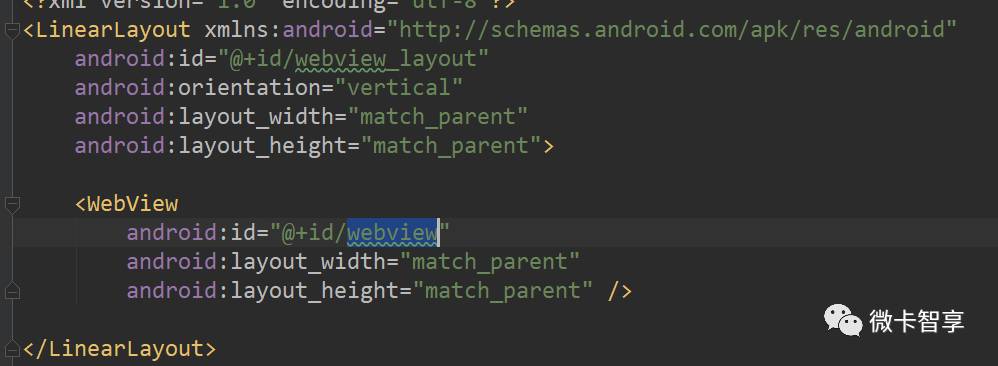本篇文章为大家展示了如何用PopWindow嵌套WebView加载页面,内容简明扼要并且容易理解,绝对能使你眼前一亮,通过这篇文章的详细介绍希望你能有所收获。
PopWindow以前用了不少,第一次尝试用WebView加载页面.用WebView可以轻松实现网页内嵌到APP里,还可以直接跟JS相互调用.Android的Webview在低版本和高版本采用了不同的webkit版本内核,4.4后直接使用了Chrome。
几个设置要点
在AndroidManifest.xml设置访问网络权限:

布局文件:

调用方法:
webView = (WebView) findViewById(R.id.webView);
//WebView加载web资源
webView.loadUrl("http://baidu.com");
//覆盖WebView默认使用第三方或系统默认浏览器打开网页的行为,使网页用WebView打开
webView.setWebViewClient(new WebViewClient(){
@Override
public boolean shouldOverrideUrlLoading(WebView view, String url) {
// TODO Auto-generated method stub
//返回值是true的时候控制去WebView打开,为false调用系统浏览器或第三方浏览器
view.loadUrl(url);
return true;
}
});
几个要点
//复写shouldOverrideUrlLoading()方法,使得打开网页时不调用系统浏览器, 而是在本WebView中显示
mWebView.setWebViewClient(new WebViewClient(){
@Override
public boolean shouldOverrideUrlLoading(WebView view, String url) {
view.loadUrl(url);
return true;
}
}
//在popwindow里面下面setBuiltInZoomControls这个属性一定不能打开,否则崩溃
webSettings.setBuiltInZoomControls(false); //设置内置的缩放控件。若为false,则该WebView不可缩放
自己封装的一个Popwindow打开WebView的类:
源码:
package scm.vaccae.basemodule;
import android.content.Context;
import android.graphics.drawable.PaintDrawable;
import android.net.http.SslError;
import android.util.DisplayMetrics;
import android.view.Gravity;
import android.view.LayoutInflater;
import android.view.View;
import android.view.ViewGroup;
import android.webkit.SslErrorHandler;
import android.webkit.WebChromeClient;
import android.webkit.WebSettings;
import android.webkit.WebView;
import android.webkit.WebViewClient;
import android.widget.PopupWindow;
/**
* Created by Administrator on 2017-11-12.
* 用PopWindow来加载WebView显示网页
*/
public class ShowWebView {
private static Context mContext;
private static View mView;
private static PopupWindow mPopupWindow;
private static WebView mWebView;
public static void show(Context context, String url) {
mContext = context;
mView = LayoutInflater.from(mContext).inflate(R.layout.webview, null);
//初始化PopWindow
InitPopWindow();
//初始化WebView
InitWebView(url);
}
private static void InitWebView(String url) {
mWebView = (WebView) mView.findViewById(R.id.webview);
//加载页面
mWebView.loadUrl(url);
//声明WebSettings子类
WebSettings webSettings = mWebView.getSettings();
//如果访问的页面中要与Javascript交互,则webview必须设置支持Javascript
webSettings.setJavaScriptEnabled(true);
// 若加载的 html 里有JS 在执行动画等操作,会造成资源浪费(CPU、电量)
// 在 onStop 和 onResume 里分别把 setJavaScriptEnabled() 给设置成 false 和 true 即可
//支持插件
webSettings.setPluginState(WebSettings.PluginState.ON);
//设置自适应屏幕,两者合用
webSettings.setUseWideViewPort(true); //将图片调整到适合webview的大小
webSettings.setLoadWithOverviewMode(true); // 缩放至屏幕的大小
//缩放操作
webSettings.setSupportZoom(true); //支持缩放,默认为true。是下面那个的前提。
//在popwindow里面下面setBuiltInZoomControls这个属性一定不能打开,否则崩溃
webSettings.setBuiltInZoomControls(false); //设置内置的缩放控件。若为false,则该WebView不可缩放
webSettings.setDisplayZoomControls(false); //隐藏原生的缩放控件
//其他细节操作
webSettings.setAppCacheEnabled(true); //启动缓存
webSettings.setCacheMode(WebSettings.LOAD_DEFAULT); //关闭webview中缓存
webSettings.setAllowFileAccess(true); //设置可以访问文件
webSettings.setJavaScriptCanOpenWindowsAutomatically(true); //支持通过JS打开新窗口
webSettings.setLoadsImagesAutomatically(true); //支持自动加载图片
webSettings.setDefaultTextEncodingName("utf-8");//设置编码格式
//复写shouldOverrideUrlLoading()方法,使得打开网页时不调用系统浏览器, 而是在本WebView中显示
mWebView.setWebViewClient(new WebViewClient(){
@Override
public boolean shouldOverrideUrlLoading(WebView view, String url) {
view.loadUrl(url);
return true;
}
//处理https请求 webView默认是不处理https请求的,页面显示空白,需要进行如下设置:
@Override
public void onReceivedSslError(WebView view, SslErrorHandler handler, SslError error) {
handler.proceed(); //表示等待证书响应
// handler.cancel(); //表示挂起连接,为默认方式
// handler.handleMessage(null); //可做其他处理
}
});
mWebView.setWebChromeClient(new WebChromeClient());
}
private static void InitPopWindow() {
//获取屏幕分辨率
DisplayMetrics metric = mContext.getResources().getDisplayMetrics();
//设置mPopupWindow大小按屏幕的十分之七来算
int width = metric.widthPixels / 10 * 7; // 宽度(PX)
int height = metric.heightPixels / 10 * 7; // 高度(PX)
mPopupWindow = new PopupWindow(mView, width,
height);
mPopupWindow.setContentView(mView);
mPopupWindow.setTouchable(true);
//必须设置背景
mPopupWindow.setBackgroundDrawable(new PaintDrawable());
//设置焦点
mPopupWindow.setFocusable(true);
//设置popupwindow出现的位置
mPopupWindow.setOutsideTouchable(true);
mPopupWindow.showAtLocation(mView, Gravity.CENTER, 0, 0);
//关闭时释放webview
mPopupWindow.setOnDismissListener(new PopupWindow.OnDismissListener() {
@Override
public void onDismiss() {
if (mWebView != null) {
mWebView.loadDataWithBaseURL(null, "", "text/html", "utf-8", null);
mWebView.clearHistory();
((ViewGroup) mWebView.getParent()).removeView(mWebView);
mWebView.destroy();
mWebView = null;
}
System.gc();
}
});
}
}
XML布局文件:
<?xml version="1.0" encoding="utf-8"?>
<LinearLayout xmlns:android="http://schemas.android.com/apk/res/android"
android:id="@+id/webview_layout"
android:orientation="vertical"
android:layout_width="match_parent"
android:layout_height="match_parent">
<WebView
android:id="@+id/webview"
android:layout_width="match_parent"
android:layout_height="match_parent" />
</LinearLayout>
调用方法:
ShowWebView.show(this, "http://www.baidu.com");
上述内容就是如何用PopWindow嵌套WebView加载页面,你们学到知识或技能了吗?如果还想学到更多技能或者丰富自己的知识储备,欢迎关注亿速云行业资讯频道。
免责声明:本站发布的内容(图片、视频和文字)以原创、转载和分享为主,文章观点不代表本网站立场,如果涉及侵权请联系站长邮箱:is@yisu.com进行举报,并提供相关证据,一经查实,将立刻删除涉嫌侵权内容。